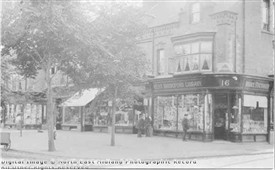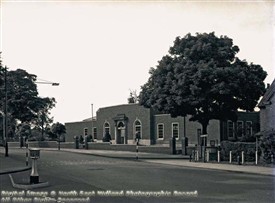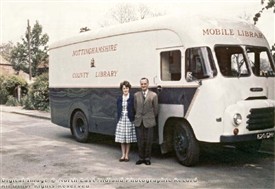A Short History of West Bridgford's Library

"Library": shop on Musters Road, 1910
A.P. Knighton

West Bridgford Library
Eric Lee

West Bridgford's Mobile Library in the 1960s
By Betty Rose
1905 – the West Bridgford Urban District Council is debating whether to take up Andrew Carnegie’s offer of £3,000 towards a free library building in West Bridgford. After 1889 Carnegie’s offer was to build and equip new libraries on condition that the local authority matched this offer by providing the land and a budget for operations and maintenance of the library. In this situation the WBUDC proceeded democratically by organising a vote in the community to gauge whether it was in favour of paying an increased penny rate for the maintenance of a library. The majority of voters voted against having a library.
1908 – Boots Book-Lover’s Circulating Library establishes a depot at Trent Bridge. It was a subscription library charging 10/6 per annum “for one volume (changed at pleasure)”. Visited daily by “crowds of people”, its main features as a successful library were “reasonable charges, skilful librarians able to give information and assist in the choice of books, prompt procuring of any book requested and a full supply of books to choose from.”
1910 – a photograph shows a shop on Musters Road with books displayed in the windows having a shop-sign that reads ‘West Bridgford Library’.
1935 – March, a Reading Room in Bridgford Hall is opened to the public and “appreciated”. Bridgford Hall had been dedicated to the public since 1923.
– in April the County boundary is extended and the population of West Bridgford bolstered by the inclusion of South Wilford. This increase in population meant that under the Public Libraries Act (1850) Nottinghamshire County Council was obliged to offer a public library service. Consequently a library rate was precepted on the WBUDC that very year! Cllr Jesse Gray complained that the WBUDC found themselves “debited £1000 and getting nothing for it.”
– Temporary Library Service in West Bridgford - in October, accepting that the library rate had to be paid, the WBUDC forms a Library Committee and requests the Council to open a temporary library, “and so they got something for the expense which had reached £1,200.” It took some time to come to terms with the prospect of having to pay a library rate. Even as the temporary library service became an instant success, with 48,000 issues in the first six months and over 3,000 borrowers (in a community of approx. 21,000), a part of the community considered the temporary library rate to be the “thin end of the wedge” and foresaw that soon the maintenance of a permanent library would exact an even higher rate.
1936 – from January the temporary library opened by Nottinghamshire County Council was located in the Reading Room at Bridgford Hall. Meanwhile the contretemps between the County Council and the WBUDC continued into the planning phase of a permanent library for West Bridgford. After refusing initially to sell land for a library to the County Council, the WBUDC recognised eventually that the community would benefit most from a library situated in what was then the children’s corner of Bridgford Park and persuaded the County Council to withdraw from negotiations it had by then nearly completed for an alternative site (the garden of West Bridgford Rectory).
1938 – building work commences for a new library on the site of the children’s corner of Bridgford Park. The County Council accepted in 1937 the tender of Messrs. R. Hofton and Son, Ltd., of Beeston, amounting to £6,183. Meanwhile the Temporary Library was sustaining demand by issuing 96,718 volumes in 1938-39.
1939, Friday 3rd March – opening of the new West Bridgford Library by Major T.P. Barber, chairman of Nottinghamshire County Council. The building contained a lending library, children’s library, study room and a reading room. The cost of the library building amounted to approx. £6,200 and the fittings £1,045. The shelf capacity of the library was about 7,000 volumes with a basement storage facility for another 6,000 volumes. During its first year the Library issued 236,434 volumes. An article in the Nottingham Guardian printed on the day mentions that the building was designed by the County Architect E.W. Roberts, and that traditional materials were used: the front façade has dressings and a centre feature of natural Clipsham stone, the main walls built in sandfaced bricks and the floors polished teak blocks laid on concrete.
1941 – a Citizen’s Advice Bureau and Information Centre is opened in West Bridgford Library’s reading room and believed to be the only one in the county staffed by members of the W.V.S.
1944 – 1949 local artists endow the Library with art works and turn part of the Library into gallery space for viewing paintings. In February 1945 the Library also hosted an exhibition of Royal Crown Derby china with accompanying lectures and workshops. In 1946 it showed Wedgwood china in April and needlework in November.
1949 – West Bridgford Library launches the first mobile library service in Nottinghamshire consisting of 2,500 books. The service targets rural areas in the West Bridgford region south of the Trent.
1963 – in November West Bridgford Library and the W.R.V.S. launch the first books on wheels service to housebound readers in the county. A van carrying 100 books serves readers in their homes. Alderman B.C. Read of the Bridgford Library Committee said: “This is the first area to have this service, and I hope that it will soon be extended to other parts of Nottinghamshire.”
1964 – West Bridgford Library launches a loan-a-record scheme open to all, with a stock of 400 12-inch LPs including classical music, documentary and spoken word recordings – but no pop!!
1965 – times are changing. “Library is like a fair” a West Bridgford woman has complained. “Children run about and pull books out of the shelves and drop them. And women gather in groups and talk noisily. I know it’s a fine library but at times it’s like a fair. It should be a refuge. People seem to take it as a meeting place. They should be told to go outside and do their chatting. I have had a letter of apology from the chief librarian. He says the people in charge of the library should remind people to keep quiet. I don’t know why they cannot adopt the practice which appeared to be successful just after the war – put up a sign saying ‘Silence’.” West Bridgford Standard, 27.3.1965
This flags up the need to modernise and extend the building to accommodate social change.
– later that same year the City proposes to extend the boundary to include West Bridgford . This proposal stirred up a very resolute opposition in the community. Interestingly, the Librarian also joined the debate and pointed out what the library service would stand to lose: “The ability to maintain the service on the present scale would vanish […]. At present […] Nottinghamshire as a library unit is large enough to be able to afford to supply books on the wide range of subjects demanded, and to buy the appropriate numbers of popular books.” Nottingham Evening Post, 22.10.1965
1969 – West Bridgford Library has an extension built in. The stock is increased, there is a reference room providing room for studying, an exhibition area and a junior library in a separate space on a floor above. The floor area of the extended library is double what it had been.
1999 – West Bridgford Library offers People’s Network computers to the public to use free of charge, enabling people to access the internet as well as a number of subscription databases and Windows software packages (from 9th December).
2008 – plans are proposed by Nottinghamshire County Council and Rushcliffe Borough Council for a new library as part of a community hub. This would be a one-stop-shop and bring together library, young people’s services, adult social care and health, benefits and advice bureau and registrars’ services under one roof. The estimated cost is £7m.
2009 – concerns are raised by English Heritage about the integration of the community hub design in the vicinity of Bridgford Hall. Altered plans for a new library were then submitted, which offered a two-storey building with meeting rooms and a council customer service centre. In response to English Heritage the new design made use of traditional materials for the building. Following local elections in May however, a change of administration at County Hall saw a reappraisal of the council’s capital programme and the plans were cancelled.
2010 – new plans for the library are drawn up retaining the original frontage, incorporating a Young People’s Centre, Shop Mobility and Registry Office.
- Self Service kiosks are in use at West Bridgford Library from 26th April.
2011 – the plans are approved and work commences on the rebuilding of West Bridgford Library on its existing site. In the meantime, the service is run from temporary premises on Rectory Road.
2013 March – opening of the new West Bridgford Library and Young People’s Centre. Nottinghamshire County Council invested £5.3m in this capital project.